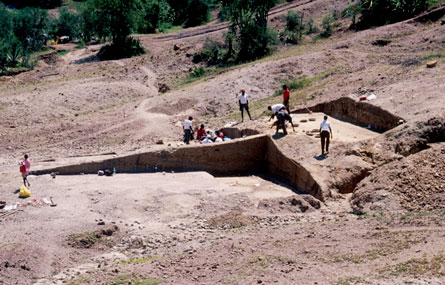Human ancestors living in East Africa 2 million years ago weren’t a steak-and-potatoes crowd. But they had a serious hankering for gazelle meat and antelope brains, fossils discovered in Kenya indicate.

Three sets of butchered animal bones unearthed at Kenya’s Kanjera South site provide the earliest evidence of both long-term hunting and targeted scavenging by a member of the human evolutionary family, anthropologist Joseph Ferraro of Baylor University in Waco, Texas, and his colleagues conclude.
An early member of the Homo genus, perhaps Homo erectus, hunted small animals and scavenged predators’ leftovers of larger creatures, researchers report April 25 in PLOS ONE. Along with hunting relatively small game such as gazelles, these hominids scavenged the heads of antelope and wildebeests, apparently to add a side of fatty, nutrient-rich brain tissue to their diets, the scientists say.
Those dietary pursuits could have provided the extra energy Homo erectus needed to support large bodies, expanded brains and extensive travel across the landscape, Ferraro says.
A few East African sites dating to as early as 3.4 million years ago had previously produced small numbers of animal bones bearing butchery marks made by stone tools. Scientists think those bones indicate occasional meat eating (SN: 9/11/10, p. 8).
Now Kanjera South has yielded several thousand complete and partial animal bones, representing at least 81 individual animals. A known reversal of Earth’s magnetic field preserved in an excavated soil layer allowed Ferraro’s team to determine the age of the finds, which accumulated over a few thousand years at most.
Hominids hunted gazelles and other relatively small animals and hauled their take back to Kanjera South, the researchers say, as evidenced by the presence of bones from the animals’ entire bodies. Stone tool marks indicate that prey were cut into parts before hunters stripped flesh from the meatiest bones. The site contains no remnants of burned wood or other signs of cooking.
Few tooth marks of lions or other predators appear on these fossils, another clue that hominids must have killed the small game.
“Hunting small animals may have been a regular behavior of 2-million-year-old human ancestors,” comments anthropologist Manuel Domínguez-Rodrigo of Complutense University of Madrid.
Researchers also found disproportionately large numbers of skulls and lower jaws in the excavated remains of antelope and other comparably sized animals with considerably more heft than gazelles. The preponderance of skulls best fits a scenario in which hominids retrieved heads left untouched by big cats that had fed on meaty parts of carcasses. Several brain cases and jaws display dents and fractures created by hammering with stones to reach tissue inside, Ferraro says.
Predators tend to devour small prey quickly, so early Homo at Kanjera South plausibly acquired gazelles via hunting, remarks anthropologist Henry Bunn of the University of Wisconsin–Madison. Further work needs to examine whether the prey animals were mainly in the prime of their lives, which would be another clue that hunting was practiced, Bunn says.
In 2010, Bunn and a colleague found mainly prime-age antelope and other prey among 1.8-million-year-old butchered bones at Tanzania’s Olduvai Gorge. Hominids with wooden spears climbed into trees and ambushed prey walking by, a tactic that the Kanjera South crowd may have employed even earlier, Bunn proposes.
Distinguishing between hunting and scavenging can be difficult based on fossils, he adds. Early Homo, for instance, could have occasionally driven predators away from fresh kills and carried away bodies of prime-age gazelles.
Likewise, says Domínguez-Rodrigo, the overrepresentation of skulls could be due to selective disposal of antelope parts after a hunt — as practiced by some hunter-gatherers today — rather than intentional scavenging of heads.







